Chapters
4 Language
When we think about how we are connected as a human species, one of the fundamental modes of our connection is language. Without some form of communication, whether oral or written or visual, we would have no way to communicate with others as part of our shared existence. Language serves as the vehicle through which we communicate, express our thoughts and emotions, and forge meaningful connections with others. It is through language that we convey our stories, transmit knowledge across generations, and bridge the gaps between cultures and societies.
It might seem like different languages are simply different collections of sounds. A “tree” in English might be arbre in French or tsin in Navajo. In reality, though, languages reflect a complex assemblage of ideas and expressions and grammar. In this way, our language is the lens through which we see and make sense of the world. Think about it for a moment—when we count in the English language using the Arabic numeral system (already a combination of languages and cultures), we use a base-10 system. Thus, when we count, we say things like twenty-eight, twenty-nine, and then we roll over to a new word once we reach another ten numbers—in this case, thirty. But not all languages use a base 10 system. Tzotzil, a Maya language, uses a base-20 system. Why? Well, we have 20 fingers and toes. The Tzotzil number for twenty-one is jun scha’vinik, meaning the first digit on the second man. In the Sora language, spoken by an indigenous group in eastern India, they use a base-12 number system and a base-20 system, so the number 34 would be conceived of as twenty-twelve-two. And those are just differences in numbering! Think about how differently you’d look at the world if you had a distinct word for light blue (mizu in Japanese), no notion of time as a distinct, abstract idea (for example, in the Amondawa language in the Brazilian rainforest), or maybe no words for discrete numbers at all (as in Pirahã language, also in the Amazon). Sometimes we think that our framework for seeing the world is universal, when in fact, it varies significantly from culture to culture and is expressed in the way we communicate to one another.
4.1 Introduction to Language
Languages are simply structured systems of communication where collections of sounds, letters, and/or symbols have shared meaning. Note that a literary tradition is not a requirement for a language nor is vocalization. Hundreds of languages are only transmitted orally, though a lack of a written language system makes these languages particularly challenging to study and document. Other languages are transmitted using hand gestures or facial expressions. Sign languages like Indo-Pakistani Sign Language (IPSL), the most widely used sign language in the world, or American Sign Language (ASL) provide rich and distinct means of expression and communication. Still other languages are characterized by their tonal nature, such as Mandarin Chinese, where the pitch or tone of a syllable can change the meaning of a word.
There are around 6,500 different languages spoken in the world today. While they might all seem quite different, we can actually group them based on shared patterns of sounds and common grammatical structures, all pointing toward a shared, historical origin. Consider your own family tree: there is your family and perhaps your siblings, cousins, or parents and they are connected to your grandparents who are connected to your great-grandparents and so on, all the way back to the first humans who ever lived. We are all connected, some more recently on humanity’s family tree and some more distantly. Similarly, we can create a family tree of languages, connecting languages that are more closely related to languages that existed in the distant past.
Let’s begin at the trunk of our language family tree. Language families include large groups of languages that were united by a common ancestral language before recorded history. There are numerous language families but the six with the greatest number of native speakers include: Indo-European (which includes English, the Romance languages, and Hindi, and comprises around 42% of the world’s population), Sino-Tibetan (which includes Mandarin), Niger-Congo (which includes Swahili and is Africa’s largest language family), Afro-Asiatic (which includes Arabic), Austronesian (which includes Javanese), and Trans-New Guinea (which includes over 400 distinct Papuan languages) (see Figure 4.1).
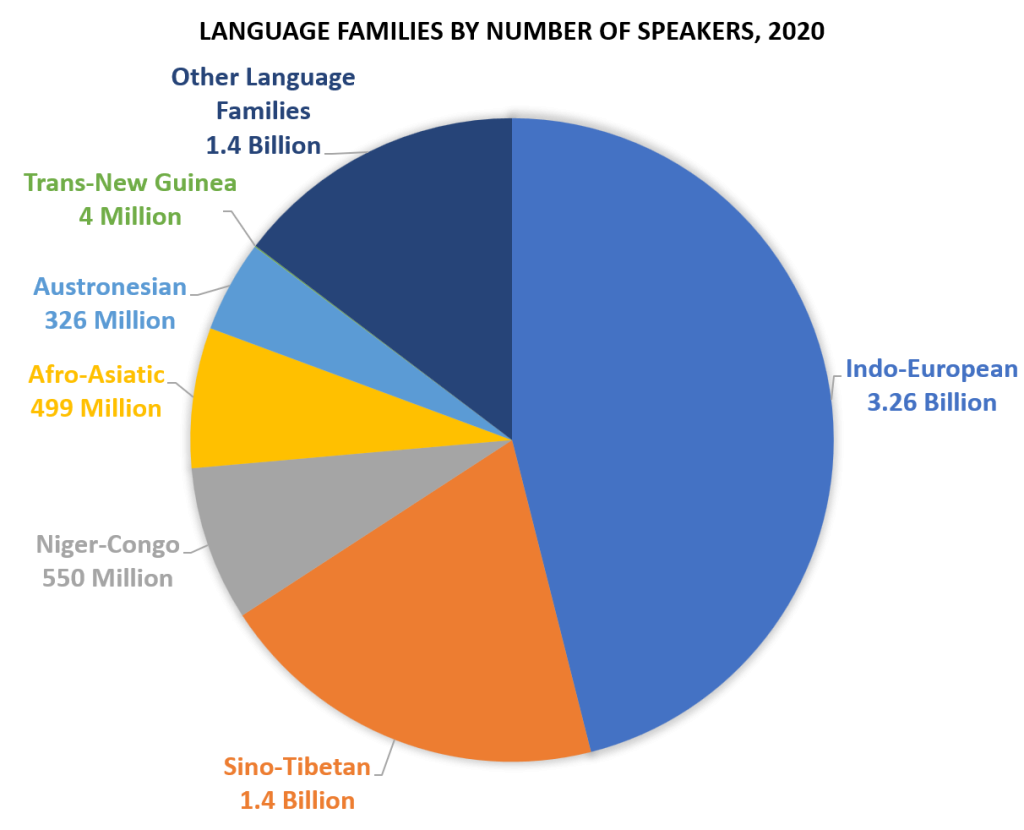
As we continue up our tree, we reach the language branches. A language branch is a collection of languages within a language family that are related through a common ancestral language that existed several thousands of years ago. For example, the Semitic language branch is a group of related languages within the Afro-Asiatic language family. Finally, a language group is a collection of languages that share a common origin in the relatively recent past. Within Indo-European language family, there is the Germanic language branch and then the West Germanic language group which includes the languages of English and German. There are numerous similarities between languages in a language group.
4.2 The Origins of Language
So, given the breadth and variety of languages in the world today, how did language first actually emerge? Which languages formed the trunks of our now immense language family tree? As mentioned, language families are those that were connected by a common ancestral language. These historical languages from which modern languages emerged are called proto-languages. Because proto-languages emerged before recorded history, we know nothing about them directly. But by studying modern languages and their histories, we can theorize with some level of confidence what the characteristics of these proto-languages might have been.
Proto-Indo-European, for instance, was the prehistoric language that eventually evolved to become modern languages like Spanish, English, Hindi, and Russian. According to archaeologist Marija Gimbutas, who formally developed what is known as the “Kurgan hypothesis,” the Indo-European languages originated with a nomadic pastoralist culture known as the Kurgans who lived in the steppes of Southeastern Europe, stretching from the northern shores of the Black Sea to the area around the Caspian Sea. The Kurgans domesticated horses and developed the chariot, which allowed them to migrate outward, beginning around 4,500 to 4,000 years ago, taking their language with them. This theory is also sometimes referred to as the “nomadic warrior theory,” alluding to the Kurgans’ need for additional grazing land for their domesticated animals and superior military technology that allowed them to conquer neighboring groups. As time passed and groups became more isolated from one another, the language morphed and took on unique characteristics for each group, eventually diverging from one another so much that they formed entirely new languages like Celtic and Germanic and Balto-Slavic. These ancient languages continued to shift and evolve, forming the modern languages we find today.
A competing theory regarding the origin and diffusion of the Indo-European is known as the “Anatolian theory,” also known as the “sedentary farmer theory.” This hypothesis, developed by archaeologist Colin Renfrew, suggests that the Indo-European language developed far earlier, around 9,000 years ago in what is now modern-day Turkey. Here, Renfrew suggests, the transition to agriculture and the development of settled farming communities created a need for new forms of communication, leading to the emergence of Proto-Indo-European, which then spread through the diffusion of agricultural practices rather than large-scale conquests. Recent genetic and linguistic research has supported the Kurgan hypothesis, though perhaps there was a combination of factors that led to the origin and dispersal of Proto-Indo-European.
Language itself is theorized to have started far earlier than even the theorized proto-languages, likely around 150,000 years ago, roughly the same time when modern Homo sapiens evolved. Some theorize that all proto-languages evolved from a single common ancestor, perhaps as a sudden evolutionary adaptation that gave a small group of ancient humans an immense advantage. Others think that language may have emerged more slowly, developing more organically out of forms of communication used by our primate ancestors. Still others believe that language developed primarily as a cultural system learned through social interaction. Regardless of its exact origins, language allowed early humans to share information, coordinate activities, form alliances, and establish social bonds, dramatically enhancing their chances of survival and success as a group.
Interestingly, while we once thought complex language was only reserved for the human species, it has become clear that many animal species possess unique forms of communication as well. Orcas, for instance, have long been known to communicate using sophisticated systems of clicks, whistles, and calls. Like humans, orcas have distinct dialects among various “pods,” or family groups. These dialects are learned and passed down through generations. Honey bees have a unique form of dance, known as the “waggle dance,” through which they can communicate a variety of navigational information to other members of the hive. Prarie dogs have an incredibly sophisticated range of vocalizations, enabling them to alert others about predators and inform them about the size, color, and speed of travel of the threat. And the list goes on! While the communication systems of these species differ from human language, they provide intriguing insights into the diversity of animal communication. They also highlight the vast amount of knowledge yet to be discovered about the origins and intricacies of our own language and the communication systems used by other species.
4.3 Language Diversity and Distribution
As mentioned, while there is an immense array of languages in the world today, we can group them into language families. There are 142 different language families in the world today (see Figure 4.2), though there is often debate over the exact divisions between language families and particularly among the branches of these families, and you may see different names for the language branches depending on the source. Let’s explore the nine most widely spoken families.
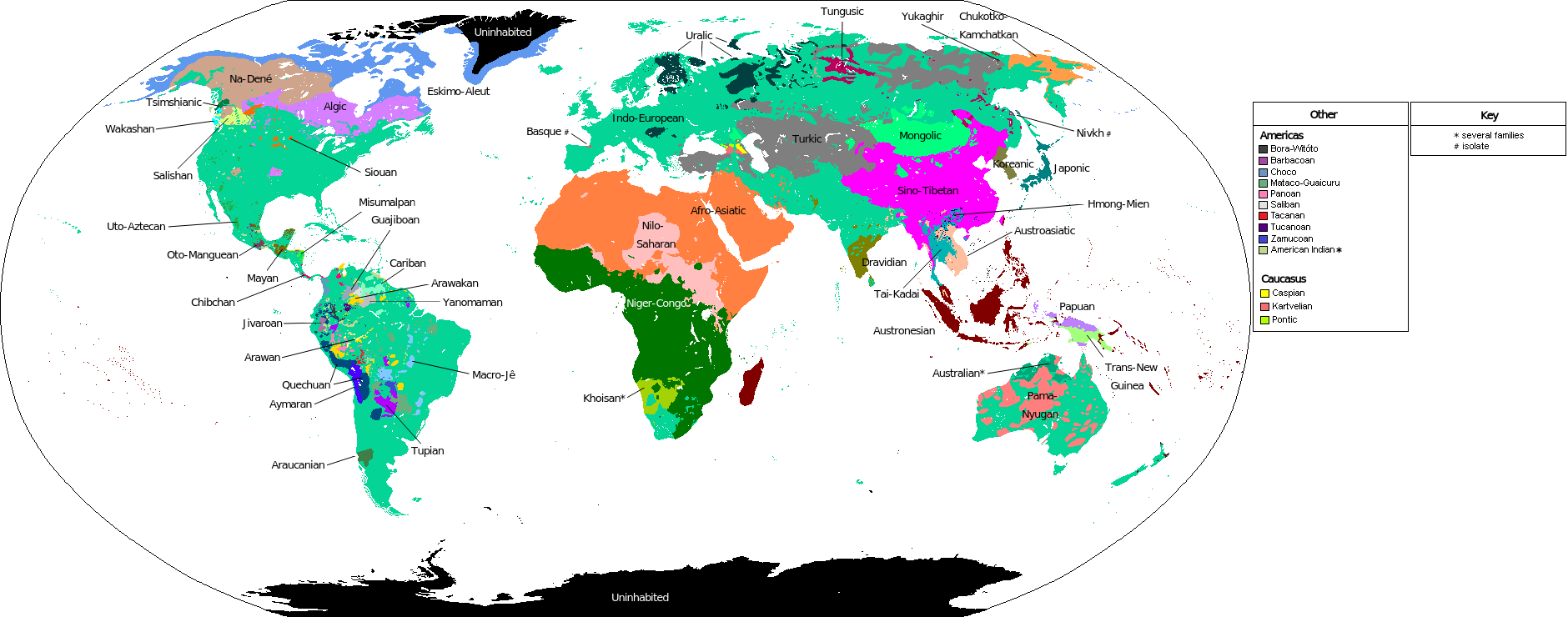
4.3.1 Indo-European
In terms of numbers of speakers, the Indo-European language family is the most widely spoken in the world with over 3.2 billion native speakers (as of 2019) including a majority of the languages spoken across Europe, Iran, and the northern Indian subcontinent. Almost half of the world speaks an Indo-European language as their first language—by far the most of any language family. There are numerous branches within the Indo-European language family. These include: Italic (containing the Romance languages, including French, Spanish, and Italian), Hellenic (Greek), Celtic (Welsh, Gaelic), Germanic (which is divided into North Germanic—including the Scandinavian languages; West Germanic—which includes German, Dutch, and English; and East Germanic—which are largely extinct), Slavic (Russian), Indo-Iranian (Persian), and Indo-Aryan (Bengali, Hindi, and Urdu), and many others. The most widely spoken native lndo-European languages are Spanish (which has the most native speakers of any Indo-European language), English, Hindi, Portuguese, Bengali, and Russian, each with over 100 million speakers. Many of these languages also spread as a second language through colonialism and conquest as well as through migration to the regions where these languages are spoken. When we consider the total number of speakers, English is the most widely spoken language in the world with over 1.4 billion total speakers.
4.3.2 Sino-Tibetan
Sino-Tibean is a language family comprised of over 400 languages and is second only to Indo-European in numbers of native speakers. The majority of Sino-Tibean speakers, around 1.3 billion people, speak a language in the Sinitic branch. Over 91% of people in China speak a Sinitic language with Mandarin the most widely spoken by far with around 920 million native speakers. Other Sinitic languages are Yue (sometimes referred to as Cantonese, though this more accurately refers to specific varieties of Yue spoken in Hong Kong and elsewhere) and Wu. The majority of Sinitic languages use logograms, written characters that represent a word or phrase. Chinese characters, for example, are considered logograms and are the oldest continually used writing system in the world. There are over 50,000 different Chinese characters, though of these, around 2,500 are among the most commonly used. Some Chinese characters, particularly the oldest characters, are pictograms, resembling the object depicted (see Figure 4.3). Characters can be combined with other characters to form new meanings, known as compound ideographs. The pictogram for “person,” for example, can be combined with the pictogram for “tree,” which means “rest.”

Burmese is another Sino-Tibetan language which is spoken in Myanmar. This language family also includes the Tibetic languages of the Tibetan plateau and the Himalayas. The spread of Tibetan Buddhism has led to the spread of these languages, such as Lhasa Tibetan, to other areas of the world.
4.3.3 Niger-Congo
In terms of the numbers of different languages, as well as geographic range, Niger-Congo is perhaps the most diverse of all the language families. There are over 1,500 individual languages as part of the Niger-Congo family, more than any other language family, and they are spoken across sub-Saharan Africa (see Figure 4.4). Over 600 million people speak a language in the Niger-Congo family.
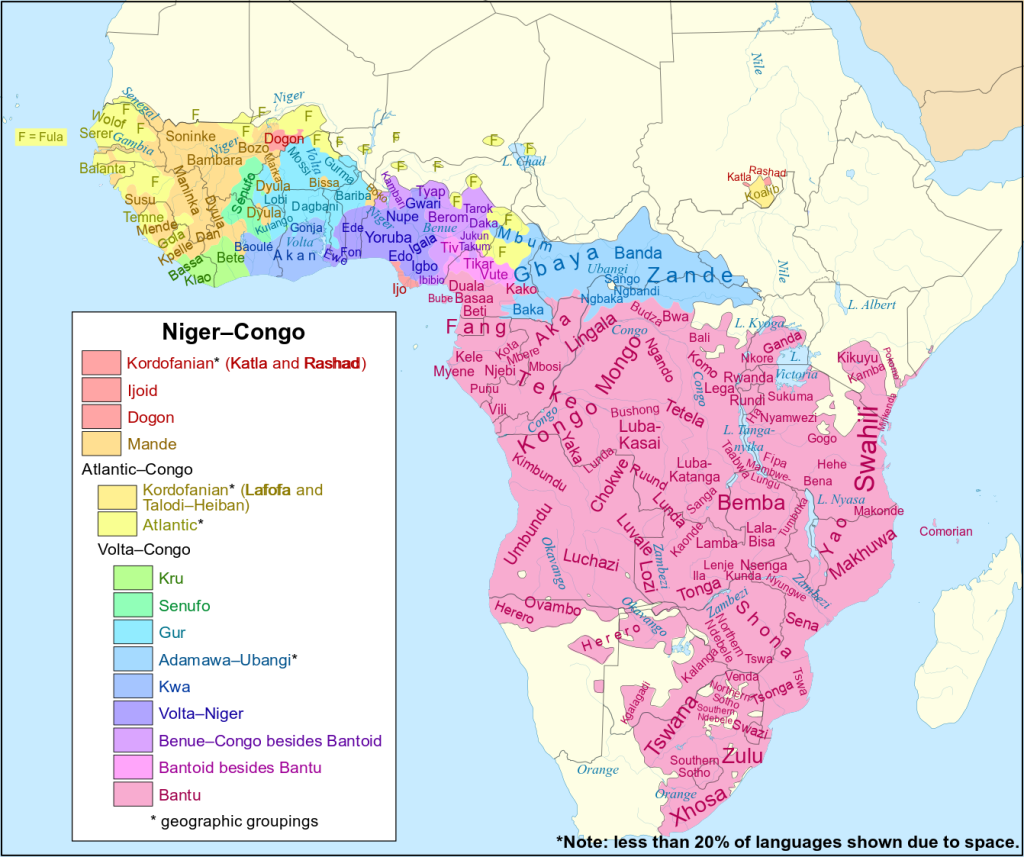
Because of the linguistic diversity of this language family, there is some debate over the divisions of the branches within the Niger-Congo family. The largest branch is the Benue-Congo, which includes the Bantu languages. More than half of Niger-Congo speakers, around 350 million, speak one of the Bantu languages, such as Swahili, Yoruba, Igbo, Zulu, Xhosa, and Shona. Swahili is also used as a lingua franca across much of East Africa. A lingua franca is a common language that is used by speakers of different native languages to communicate. Often, lingua francas are used to facilitate commerce or during diplomatic meetings between representatives of different countries. In areas where there are a multitude of different, individual languages spoken, having a common lingua franca allows for communication without everyone having to learn each individual language. Numerous lingua francas have existed throughout history, often emerging as a consequence of colonization. Swahili has also emerged as a language of technology across Africa, and a number of applications have been developed for Swahili to include spell checkers, language learning software, and a robust Swahili Wikipedia.
The Bantu languages are based on a noun class system where each noun is categorized into different classes and each class is associated with specific prefixes and agreement markers that affect other elements of a sentence, such as adjectives and verbs. For example, the Swahili word for “a person” is mtu. It is in a class of nouns that use the wa- prefix to make the word or phrase plural. Thus, “a good person” would be mtu mzuri, while “good people” (plural) would be watu wazuri.
4.3.4 Afro-Asiatic
Afro-Asiatic is a language family spoken in northern Africa, Western Asia, and the Horn of Africa. This language family includes the Semitic language branch, which is spoken by more than 330 million people. Arabic and Hebrew are both Semitic languages and like most Semitic scripts, are based on sets of consonants (generally three letters) which carry root meanings. The root S-L-M, for instance, in both Arabic and Hebrew, means “peace.” The written forms of these languages typically omit some or all of the vowel markings. However, vowels are important because they form words using these base consonantal roots and vowel markings are often used by language learners. For non-native speakers, Arabic and Hebrew script may appear to be completely different from one another, but examining them more closely and the transliterations (converting their sounds into corresponding English letters) reveals similarities that point toward a shared linguistic history (see Figure 4.5).
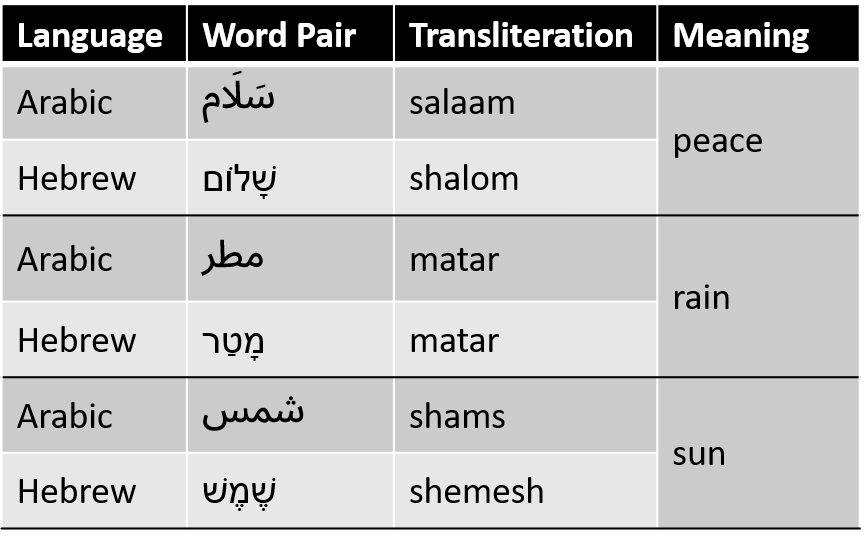
In addition, because vowel markings are not typically used in writing, it is difficult to deduce what the vowel sounds may have been in Proto-Semitic languages but these languages are among the oldest on Earth. Ancient Semitic script was written in cuneiform, a combination of logos and syllables, as far back as 3000 BCE (see Figure 4.6). Akkadian is the earliest documented Semitic language and used the familiar system of consonantal roots that we find in modern Semitic languages today. Egyptian, which is now extinct, and Hausa, which is widely spoken across West and Central Africa, are also Afro-Asiatic languages.
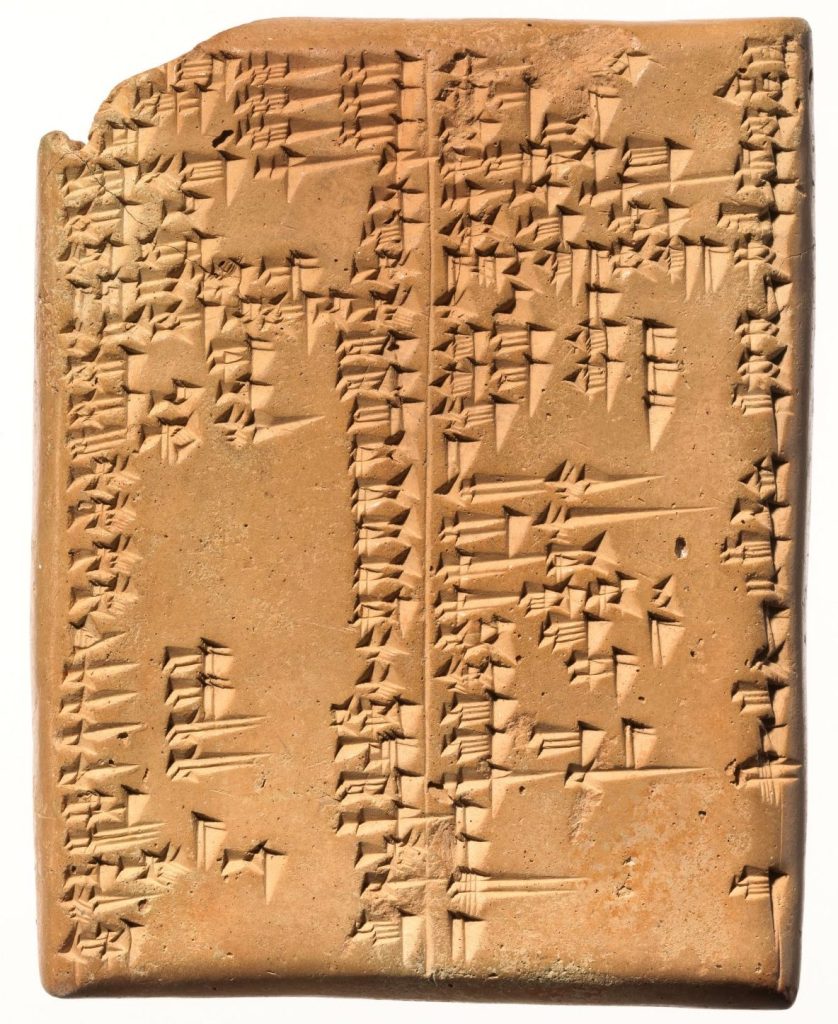
4.3.5 Austronesian
The Austronesian language family includes the majority of the languages spoken across the Pacific islands, stretching across a vast area from Easter Island across the ocean to New Zealand and Indonesia. Most of the these languages are spoken by Pacific Islanders, though Malay is also spoken in mainland Asia. Because many of these languages are spoken on relatively isolated islands, some have only a few number of native speakers remaining. It is particularly difficult to discern the division between branches of the Austronesian family because the family consists of many similar and closely related languages that may only vary slightly between them. A primary division is between the Formosan language branch (which includes the languages of the indigenous peoples of Taiwan) and Malayo-Polynesian (which is a much larger branch and includes Indonesian, Malay, Tagalog, Samoan, Fijian, Tahitian, Rapa Nui), and most of the other languages of the Pacific islands. Interestingly, the Disney animated film Moana, which is based on the culture and heritage of this region, was the first feature film to be translated into the Tahitian language.
Indonesian, the official and national language of Indonesia, is spoken by over 200 million people regularly and is a lingua franca for Indonesia, with most Indonesians speaking an indigenous language in addition to the national language. Indonesian has a straightforward grammatical structure, without complex verb conjugations or rigid rules, and the words are phonetic, spoken as they are spelled (such as with Spanish). Indonesian also uses the Latin alphabet, unlike most other Asian languages. Thus, Indonesian is considered to be one of the easiest languages to learn, particularly for English speakers.
4.3.6 Dravidian
Dravidian languages are spoken in Southern Asia, such as South India and Sri Lanka. There are 250 million native speakers in the Dravidian language family, which includes the languages of Telugu, Tamil, Kannada, and Malayalam. Many Dravidian languages have long literary traditions, with written inscriptions dating back to the 2nd century BCE.
4.3.7 Turkic
Over 200 million people speak a Turkic language, the majority of which speak Turkish. Turkic also includes the Uzbek language. Some linguists previously included the Turkic family in a larger Altaic family, which also included Mongolian and Tungusic (spoken in Siberia), though the Altaic language family has been less accepted by researchers in recent decades. Turkish was previously written using the Arabic alphabet, but the government of Türkiye mandated a switch to the Latin alphabet in 1928 that was meant to modernize Türkiye and increase literacy.
4.3.8 Japonic
This language family includes Japanese, which has around 128 million native speakers primarily in Japan. Written Japanese has three different scripts: kanji, hiragana, and katakana. Kanji uses Chinese characters with Japanese pronunciations, though the meaning of some characters are different in each language. Hirigana is a phonetic lettering system and katakana is used for transcribing foreign-language words or writing technical or scientific terms. This family also encompasses the Ryukyuan languages, languages indigenous to the Ryukyu Islands, an island chain in the southernmost part of Japan that includes Okinawa.
4.3.9 Trans-New Guinea
The languages are spoken on the island of New Guinea and neighboring islands like East Timor. While only around 3 million people speak one of these languages, there are over 400 individual languages within this family. Most are spoken by only a few thousand people. The most widely spoken are (Melpa, Kuman, Enga, Huli, Western Dani, Makasae, and Ekari, each with over 100,000 speakers).
4.4 The English Language
As mentioned, English is a language within the Indo-European language family, but examining the English language more closely reveals a number of complexities—and hints at the difficulties of categorizing and dividing languages. English is considered to be in the Germanic branch of the Indo-European family, and within the Germanic branch, English is in the West Germanic group, along with German and Dutch. The language itself is named after the Angles, a tribe of Germanic people who settled in Great Britain after the collapse of the Roman Empire. (The name “England” comes from “Land of the Angles.”)
Speakers of English, either as a native or second language, can certainly see similarities between English and German. Some words are even the same or very similar: mutter/mother, buch/book, wasser/water, vater/father, gold/gold, name/name, angst/angst. The list goes on! But there are other words in English that don’t look German at all. Consider the words cuisine (in German, küche), celestial (himmlisch), equestrian (reiter), accident (unfall), and so on.
The English language was shaped not only by the migration of the original Germanic speaking Angles tribes, but later by the Norman Conquest of England in 1066 CE. Normandy was a region in northern France ruled by the Duke of Normandy, William the Conqueror. The invading Normans spoke French, and introduced Norman-French as the language of the ruling class. They also instituted a French legal and administrative system and architecture. As a result, modern English has some words that are connected to its German roots and others to French, and in many cases, there are two words to describe a similar idea: one word stemming from German and the other from French (see Figure 4.7).
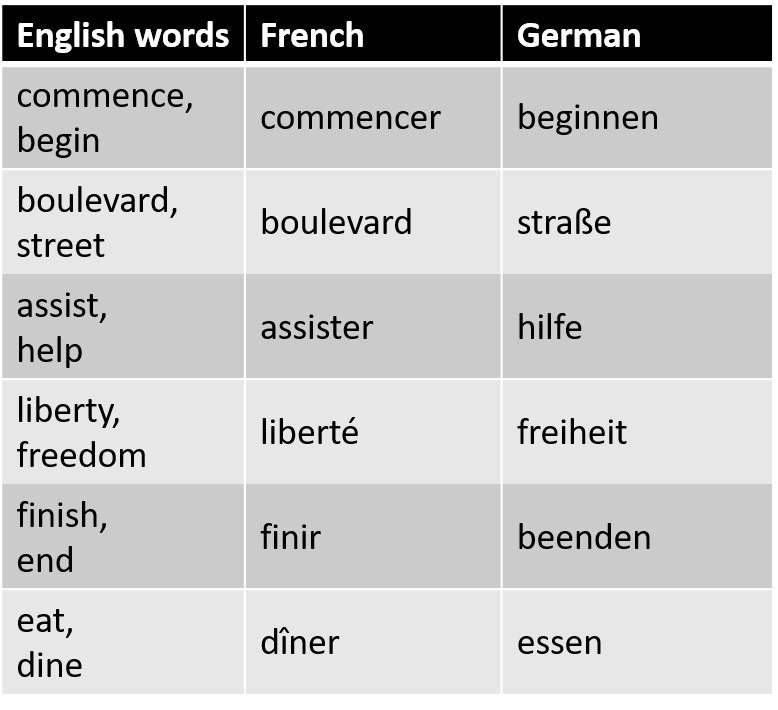
Complicating English further is that there are a number of different dialects, which is also the case with numerous other languages that are spoken over a wide geographic area. A dialect is a variety of a language that is distinct from other regional or social varieties. Generally, dialects are mutually intelligible, but there might be differences in spelling, vocabulary, grammar, and/or punctuation. The English language has numerous different dialects from Received Pronunciation, associated with higher class British boarding schools, to Scottish English to American English to Australian English. Within dialects, we often find numerous different accents. Accents and dialects are similar, and often it is difficult to determine if a variation of a language is a distinct dialect or is an accent. In general, accents refer to differences in how people pronounce words while dialects refer to broader differences not only in pronunciation but also in vocabulary and grammar. Furthermore, as we zoom in to a particular region, sometimes we find dialects or accents within dialects, like a language fractal. Within American English, for example, we find a Southern dialect (sometimes colloquially referred to as a “Southern accent”) and if we zoom in even more, we find regional dialects or accents specific to certain places, such as Appalachian English.
Dialects often emerge as a result of isolation, such as in the case of Appalachia or northern Scotland, where settlers may have had limited contact with other groups after they migrated as a result of the formidable terrain. Colonization and imperialism can also lead to the creation of new dialects. Indian English, for example, is a group of dialects spoken across India and among Indian migrants resulting from British colonization of that region. Broadly, migration and interaction (or a lack thereof) can influence how a language is spoken. Consider African American Vernacular English (AAVE), which has its own unique grammar, vocabulary, and accents. There are some parallels between AAVE and the structure of West African languages. These languages may have influenced the grammatical structure of the dialect, though linguists disagree on its exact origins. Social class, too, can influence a dialect’s emergence and distribution. Cockney, for example, is a dialect spoken amongst working-class and lower-class Londoners.
The worldwide spread of English has also led to the emergence of pidgin languages. These are simplified forms of communication that develop between speakers of different native languages. Often, pidgin languages have a very basic grammatical structure, such as a lack of different grammatical tenses or a lack of clear parts of speech. Tok Pisin, for example, is an official language of Papua New Guinea and is the most widely used language in the country. It developed as a result of Pacific Islanders intermixing after they were sent to work on plantations in Queensland, Australia and the surrounding areas. Tok Pisin retains some English vocabulary, often with variations in spelling and/or pronunciation (sik means “sick,” for example and plis means “please”), while its syntax often resembles that of the underlying Austronesian languages. Between five and six million people use Tok Pisin and while pidgin languages were generally only second languages historically, many now learn them as a first language. Similar to lingua francas, the practicality of pidgin languages often leads to their greater usefulness in commercial settings compared to indigenous languages and in some cases, pidgin languages have crowded out native tongues. As pidgin languages are passed on to later generations and have native speakers, they become known as creole languages.
One key reason why English has dominated the global linguistic landscape in modern times is the internet. Over 60 percent of all websites use English as the language of their content, and in this way, English has become a global lingua franca. It is estimated that one-quarter of all internet users speak English. While almost 20 percent of all internet users speak Mandarin, only around 1 percent of websites are in Mandarin. A majority of YouTube channels are in English as well. More broadly, English has become the language of popular culture. English language songs dominate music streaming charts and English language films almost exclusively represent the highest-grossing films in the global box office (with 97 of the 100 highest-grossing films in English).
Things are starting to change, though. Over the past decade, English has lost ground in Spanish-language areas with regard to music. Puerto Rican rapper and singer Bad Bunny, for example, had the first album entirely in Spanish to reach number one on the Billboard 200 in 2020 and he was the first non-English singer to be Spotify’s most streamed artist of the year. In areas with a long tradition of local music cultures, such as in Brazil and Japan, English-language songs no longer dominate the charts. Korean language popular culture has also exploded in popularity, from the hugely successful BTS boy band (the first non-English-speaking act to sell out a concert in London’s iconic Wembley Stadium) to the television series Squid Game (Netflix’s most-watched original series). These recent breakout successes are evidence not only that native speakers support media in their own language, but also that native English speakers are open and excited for media content in a variety of other languages as well.
4.5 Language Evolution and Change
Languages are always changing and evolving, as evident from comparing historical literature to modern writing. The collection of stories in The Canterbury Tales dates to around 1400 CE and represents a form of English known as “Middle English,” which was spoken from the time of the Norman Invasion to the 15th century. Not only does it exhibit variations in spelling and vocabulary compared to Modern English, but it also demonstrates distinct differences in grammar and pronunciation. Readers of Shakespeare will similarly recognize differences between the Early Modern English used by the writer and Modern English. The words thou and ye were commonly used, for example, and a number of words have changed in meaning over time. For instance, the famous question “Wherefore art thou Romeo?” from the play Romeo and Juliet doesn’t mean “Where are you, Romeo?” as it might in Modern English. “Wherefore” during that time period instead meant “why.” Other words have similarly shifted in meaning, such as the word “awful,” which meant inspiring awe or worthy of respect in Old English, but has changed over time to mean something terrible.
Just as English has morphed and shifted over time, so too have the other languages of the world. Modern Spanish, for example, varies significantly from Old Castilian. Classical Chinese, used in ancient Chinese literature, differs from Mandarin Chinese in a number of ways. Notably, it’s generally monosyllabic and is much more compact and concise compared to modern Chinese translations of the same text. Our ability to trace the evolution of languages over time helps us understand how languages were related historically.
In general, languages adapt and transform in response to cultural, social, and technological shifts, as well as a result of interactions between different linguistic communities. When English colonists first encountered some unusual animals in North America, they often borrowed the Native American words for them. The word “moose,” for instance, is derived from the Algonquian word mooswa, which means “twig eater.” “Opossum” comes from the Powhatan word apasum, meaning “white animal.” Technological innovations sometimes led to isolated communities who spoke the same language to develop different words for the same invention. For instance, in American English, the term “flashlight” is used to describe a handheld portable lamp, while in British English, it’s referred to as a “torch.” Similarly, the word “elevator” is used in American English, whereas in British English, it’s commonly known as a “lift.” New words continue to be introduced into languages. These additions may emerge to describe innovations or new ideas, such as the words “streaming,” “selfie,” or “emoji.” Emojis themselves have come to have their own set of meanings and interpretations, which can change generationally. Words sometimes arise from brand names and shift to become more generic terms (like “googling” referring to internet searches) and in some cases fall back out of usage (such as the word “Xerox” referring to making a copy on a copy machine, which was once widely used but is now less common).
With globalization and an increase in global interaction, languages often borrow words from other languages, such as the English words “sushi” (from Japan) or “entrepreneur” (from France.) Similarly, the words “TV” and “pizza” are commonly used across a variety of languages. Words may become popular within a generation but then fall out of fashion. “Groovy” was commonly used in the 1960s to describe something stylish but is rarely used to today. Similarly, “rad” was common in the 1980s. Neologisms refer to newly coined words or phrases that have been introduced into a language and become more recognized. The terms “laser” and “robot” were examples of neologisms historically. Today, new words emerge on social media platforms, which then accelerate their spread.
4.6 Endangered Languages
If we think of languages as very much alive, shifting and adapting and changing with every generation, we can also understand languages as being somewhat fragile. There is a delicate balance between the world’s linguistic diversity and the forces of change we find in our modern society. In fact, it is estimated that one language dies out every two weeks or so. Consider the wealth of knowledge and the understanding of the world that is lost along with these systems of communication.
Just as we classify animal species as “endangered” or “extinct,” we can do the same with languages. An endangered language is a language that is at risk of disappearing. The United Nations Educational, Scientific and Cultural Organization (UNESCO) maintains an online atlas of the world’s endangered languages and, as of 2023, it lists 846 languages as either “severely” or “critically” endangered. Of the 6,500 or so languages spoken in the world today, researchers estimate that somewhere between 50 and 90 percent will be severely endangered by the year 2100 (see Figure 4.8).
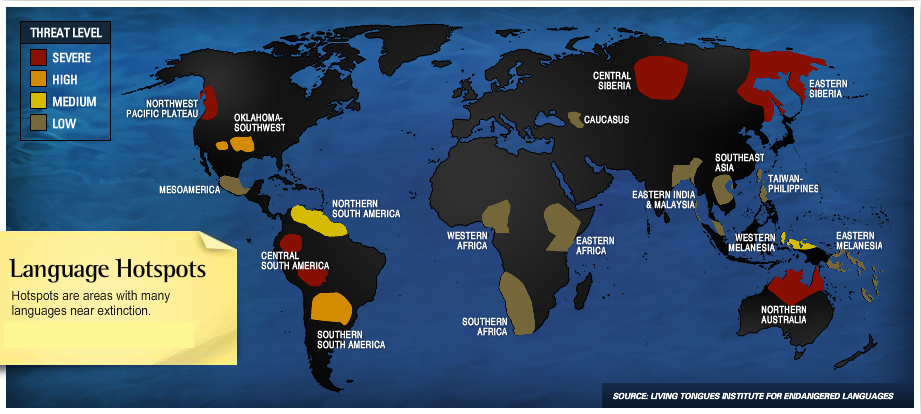
Why might languages become endangered? Generally, languages disappear as a result of colonization, conquest, or the presence of a more dominant language in the region. Within the United States, for example, many American Indian children were sent to boarding schools during the late nineteenth through mid-twentieth centuries where they were forced to speak English, adopt American cultural customs, and were punished for speaking their native language. Sometimes, indigenous languages aren’t actively discriminated against, but the presence of a more dominant language of trade and the lack of local languages used in schools leads to a decreasing number of speakers with each generation. At the first stage of endangerment (categorize by UNESCO as “vulnerable”), speakers of vulnerable local languages may feel pressure to learn a more widely spoken global language, but they still pass their native language on to their children. Over time, there may be only a few speakers left and their children are no longer learning the language, perhaps only learning a few words or phrases. At some point, only a few, often elderly speakers remain. These languages are categorized as “critically endangered.” The Hokkaido Ainu language of Japan, for example, only has nine remaining native speakers. The Resígaro indigenous language of Peru had only one remaining speaker as of 2017.
Once no speakers of a language remain, that language is considered to be extinct. When these languages die out, a unique piece of how humans see and understand the world dies with them. Furthermore, because language and culture are so closely intertwined, it represents a loss of a key marker of cultural identity. In 2021, the last remaining native speaker of Wukchumni, a group of Native Americans indigenous to California, died. The speaker and her daughter worked to create a Wukchumni dictionary before her death and she also worked on an audio dictionary.
Sometimes, languages can be revived, either reversing trends in the decline of a language or resurrecting a language that was previously extinct. Some researchers and advocates, for example, have worked closely with indigenous groups to ensure their language is documented, preserved, and encouraged. There are a number of organizations working to preserve endangered languages and ensure their survival. The Living Tongues Institute for Endangered Languages, for example, maintains a multimedia “living dictionary” that includes video and audio of native speakers. The popular language learning app Duolingo now includes the endangered languages of Hawaiian and Scottish Gaelic as well as vulnerable languages like Haitian Creole, Navajo, Norwegian Bokmål, Welsh, Yiddish, and Zulu, with more endangered languages on the way.
It is important to differentiate between extinct languages and dead languages. Dead languages, like Latin, have no remaining first-language speakers, though speakers still learn the language as a second language. Other examples of dead languages are those used solely for ceremonial or religious purposes. Sanskrit, for example, is considered by some scholars to be a dead language since it is largely reserved for sacred texts and religious rituals and festivals, though there has been significant work to revive it in recent years.
Perhaps the most successful example of a revived language is Modern Hebrew, which was effectively dead and used only in religious ceremonies until the late nineteenth century. Hebrew’s revival was largely owed to Eliezer Ben-Yehuda who compiled the first Hebrew dictionary in 1908. One challenge with reviving Hebrew, as with other extinct or dead languages, is that many modern terms didn’t exist in liturgical Hebrew. There is no word for car, newspaper, or muffin in the Hebrew Bible, for just a few examples, and thus a huge array of new words had to be created, sometimes drawing from Biblical Hebrew and other times borrowing from words in other languages. Hebrew prevailed as the official language of the state of Israel and today, around Hebrew is spoken by around 9 million people worldwide.
Reviving endangered languages is not without challenges, however, as an example in Wales demonstrates. In an effort to preserve the Welsh language, which has been quite successful, road signs in Wales are required to be bilingual. So, when a road sign went up in Swansea, officials sent an email asking for a translation and received what they assumed was the Welsh translation in reply and printed it on the sign (see Figure 4.9). Unfortunately, the Welsh text of the sign read: “I am not in the office at the moment. Send any work to be translated.”

Ultimately, Hebrew remains the only case of a total revival of a dead language with a now self-sustaining community of several million native speakers. Still, new technologies and a greater attention toward the importance of preserving languages has often slowed or reverse language decline. The Maori language of New Zealand is now taught in a variety of settings, including immersion schools and in college programs, and media programs are now broadcast in Maori. These changes have resulted in an increasing number of children being taught Maori, reversing decades of declines. Speakers of more widely spoken languages can help support the preservation of endangered languages through partnering with organizations helping to preserve language diversity, speaking with local leaders about initiatives to preserve indigenous languages in the community, or or even through learning one of the many minority languages spoken across the world. Our language is how we tell our story and thus preserving language preserves unique ways of seeing our world.
a structured system for communication
a large group of languages that were united by a common ancestral language before recorded history
a collection of languages within a language family that are related through a common ancestral language that existed several thousands of years ago
a collection of languages that share a common origin in the relatively recent past
a theorized ancestral language from which a group of related languages is believed to have evolved
a written character that represents a word or phrase
a common language that is used as a means of communication between speakers of different native languages, often for the purposes of trade or diplomacy
a particular regional speech pattern found within a language
a difference in the pronunciation of words within a language
a simplified form of communication that develops as a means of interaction between speakers of different native languages
a language at risk of becoming extinct
a language with no remaining speakers

